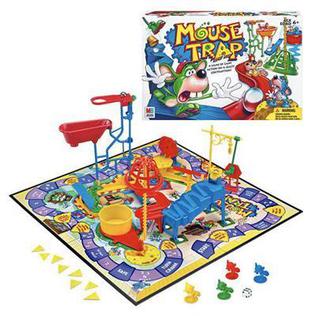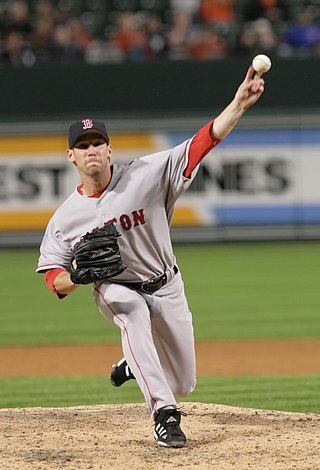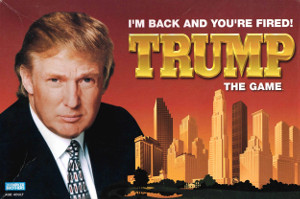
A frisbee, also called a flying disc or simply a disc, is a gliding toy or sporting item that is generally made of injection-molded plastic and roughly 20 to 25 centimetres in diameter with a pronounced lip. It is used recreationally and competitively for throwing and catching, as in flying disc games. The shape of the disc is an airfoil in cross-section which allows it to fly by reducing the drag and increasing lift as it moves through the air, compared to a flat plate. Spinning the disc imparts a stabilizing gyroscopic force, allowing it to be both aimed with accuracy and thrown for distance.

Tapper, also known as Root Beer Tapper, is a 1984 arcade game developed by Marvin Glass and Associates and released by Bally Midway. Tapper puts the player in the shoes of a bartender who must serve eager, thirsty patrons while collecting empty mugs and tips. It was distributed in Japan by Sega in 1984.

Simon is an electronic game of short-term memory skill invented by Ralph H. Baer and Howard J. Morrison, working for toy design firm Marvin Glass and Associates, with software programming by Lenny Cope. The device creates a series of tones and lights and requires a user to repeat the sequence. If the user succeeds, the series becomes progressively longer and more complex. Once the user fails or the time limit runs out, the game is over. The original version was manufactured and distributed by Milton Bradley and later by Hasbro after it took over Milton Bradley. Much of the assembly language code was written by Charles Kapps, who taught computer science at Temple University and also wrote one of the first books on the theory of computer programming. Simon was launched in 1978 at Studio 54 in New York City and was an immediate success, becoming a pop culture symbol of the 1970s and 1980s.

Mouse Trap is a board game first published by Ideal in 1963 for two to four players. It is one of the first mass-produced three-dimensional board games. Players at first cooperate to build a working mouse trap in the style of a Rube Goldberg machine. Then, players turn against each other to trap opponents' mouse-shaped game pieces.
Rock 'Em Sock 'Em Robots is a two-player action toy and game designed by Marvin Glass and Associates and was first manufactured by the Marx toy company in 1964. It features two dueling robot boxers, Red Rocker and Blue Bomber, mechanically manipulated by the players, and the game is won when one player knocks the opposing robot's head up and off the shoulders. The 2000s version of the game by Mattel features physically smaller robots.

Lite-Brite is a toy that was originally marketed in 1967. It consists of a light box with small colored plastic pegs that fit into a panel and illuminate to create a lit picture, by either using one of the included templates or creating a "freeform" image on a blank sheet of black paper.

Marvin Glass and Associates (MGA) was a toy design and engineering firm based in Chicago. Marvin Glass (1914–1974) and his employees created some of the most successful toys and games of the twentieth century such as Mr. Machine, Rock 'Em Sock 'Em Robots, Lite Brite, Ants in the Pants, Mouse Trap, Operation, Simon, Body Language, and the Evel Knievel Stunt Cycle.
Ants in the Pants is a game designed by Marvin Glass and Associates, who sold the rights to William H. Schaper, and was originally produced in 1969 by Schaper's company Schaper Toys. In 1986 it was purchased by Hasbro, which still manufactures and markets the game.
Big Monster Toys, LLC (BMT), established in May 1988, is a United States-based toy and game inventing and licensing company.

Garry Kitchen is a video game designer, programmer, and executive best known for his work at Activision during the early years of the company's history. He has developed games for the Atari 2600, Commodore 64, Nintendo Entertainment System, and Super Nintendo Entertainment System, as well as co-founded Absolute Entertainment with ex-Activision developers. His port of Donkey Kong for the Atari 2600 was a major hit for Coleco, selling over 4 million copies. His other 2600 work includes Keystone Kapers and Pressure Cooker for Activision and Space Jockey for U.S. Games. He also wrote Garry Kitchen's GameMaker and The Designer's Pencil for the Commodore 64.

Craig Andrew Breslow is an American baseball executive and former professional baseball pitcher. He is currently the Chief Baseball Officer of the Boston Red Sox. Breslow pitched for 12 seasons in Major League Baseball (MLB) for the San Diego Padres, Boston Red Sox, Cleveland Indians, Minnesota Twins, Oakland Athletics, Arizona Diamondbacks, and Miami Marlins. He also pitched for Team Israel at the 2017 World Baseball Classic.

Toss Across is a game first introduced in 1969 by the now defunct Ideal Toy Company. The game was designed by Marvin Glass and Associates and created by Hank Kramer, Larry Reiner and Walter Moe, and is now distributed by Mattel. It is a game in which participants play tic-tac-toe by lobbing small beanbags at targets in an attempt to change the targets to their desired letter. As in traditional tic-tac-toe, the first player to get three of their letters in a row wins the game. There are other similar games to Toss Across known under different names, such as Tic Tac Throw.

Norman Edward Breslow was an American statistician and medical researcher. At the time of his death, he was Professor (Emeritus) of Biostatistics in the School of Public Health, of the University of Washington. He is co-author or author of hundreds of published works during 1967 to 2015.

Mystery Date is a board game from the Milton Bradley Company released in 1965, conceived by Marvin Glass and created by Henry Stan. Marketed to girls 6 to 14 years of age, it has been reissued in 1970, 1999, and 2005. It is popularly referenced as a trope in TV and film.

George Gomez is an industrial designer, video game designer, and pinball designer who has worked for Bally, Williams, and Stern Pinball, among other companies. He has designed or contributed to several notable games, including Tron (1982), NBA Fastbreak (1997), and Monster Bash (1998).

Milton is an electronic talking game. According to the patent, Milton was the first electronic talking game that allowed two people to play against each other. Previously released devices of this type, such as Speak & Spell by Texas Instruments, were known primarily as teaching devices rather than competitive games.
IPS is a screen technology for liquid-crystal displays (LCDs). In IPS, a layer of liquid crystals is sandwiched between two glass surfaces. The liquid crystal molecules are aligned parallel to those surfaces in predetermined directions (in-plane). The molecules are reoriented by an applied electric field, whilst remaining essentially parallel to the surfaces to produce an image. It was designed to solve the strong viewing angle dependence and low-quality color reproduction of the twisted nematic field effect (TN) matrix LCDs prevalent in the late 1980s.

Trump: The Game is a board game named after Donald Trump. Milton Bradley Company initially released the game in 1989, but it sold poorly, with only 800,000 copies sold out of an expected two million. Parker Brothers re-released Trump: The Game in 2004 following the success of Trump's reality television series, The Apprentice, from earlier that year. Trump: The Game received poor reviews from critics and the public audience.
Dan Klitsner is the founder and creative director of toy inventing and licensing firm KID Group LLC.
A. Eddy Goldfarb is an American toy inventor. The creator of over 800 toys, he is best known for inventing Yakity Yak Talking Teeth, Battling Tops, KerPlunk, Stompers, and Vac-U-Form. He is the subject of the award winning short film Eddy's World.












